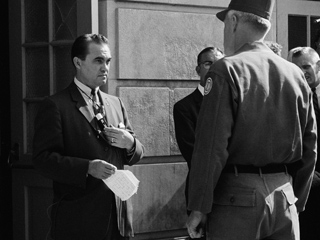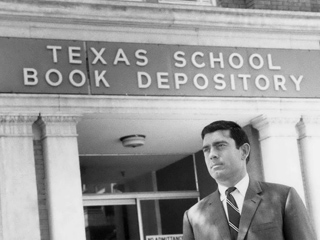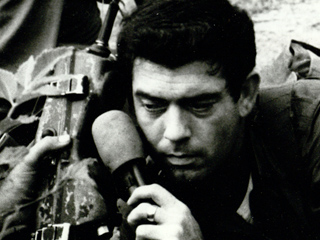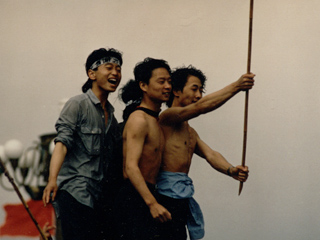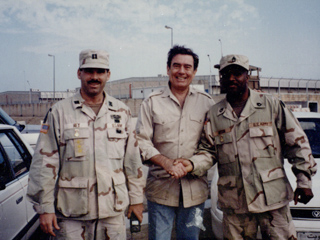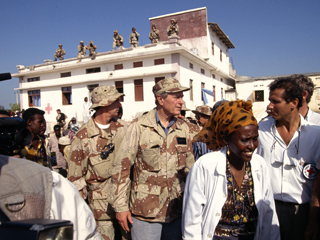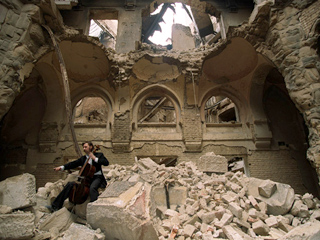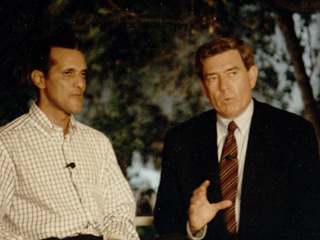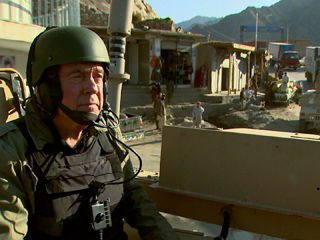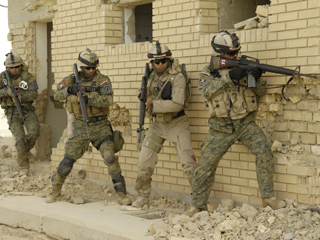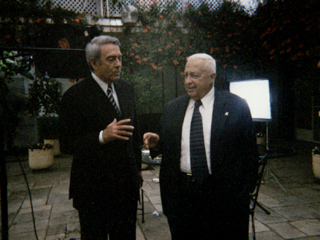Dan Rather has been on the ground to cover many of the major domestic and international crises and conflicts since the 1960s. Traveling around the globe, he kept American viewers informed about issues that had broad repercussions and that often involved American troops. While some of the major foreign events he worked on can be found in our "Foreign Affairs" section, a selection of the crises Rather reported about is presented here.
Civil Rights Movement
On-air segment of Dan Rather on his experience covering the civil rights movement in the South in the 1960s. Rather (Dan) Papers, e_rathe_00046_003, Briscoe Center for American History.
As the head of the CBS Dallas bureau in the early 1960s, Rather was responsible for 23 states, Mexico and Central America. The civil rights movement quickly became the major story Rather and his team, made of Nelson Benton, Lew Wood, and cameramen Wendell Hoffman and Laurens Pierce worked on. In October 1961, Rather talked for the first time with Dr. Martin Luther King Jr. and Andrew Young in Albany, Georgia, and then covered their struggle in Atlanta, Birmingham, Meridian, Mississippi, and Jackson, Mississippi. He documented James Meredith's difficult integration of the University of Mississippi in Oxford in September 1962 and reported live on the confrontation with George Wallace as Vivian Malone and James Hood tried to enter the University of Alabama. Rather was the first to report the death of Mississippi NAACP representative Medgar Evers in June 1963, and he announced in a CBS Special Report the assassination of Dr. Martin Luther King in 1968.
Reporting on the racial conflicts was one of the most difficult assignments Rather had ever done at that point: emotionally and psychologically difficult, but also physically dangerous, as journalists often faced the angry opposition of white local residents as well as the refusal of the southern CBS affiliates to process and often broadcast the material Rather and his team had shot. The network, which produces and broadcast numerous pieces on the civil rights movement, was nicknamed the Colored Broadcast System by its opponents. Profoundly changed by his experience, Rather has remained sensitive to issues of race in America. In 2011, he was invited to speak at the unveiling of the Martin Luther King Memorial.
Materials
Kennedy Assassination
Miscellaneous clips of Rather covering President Kennedy's assassination in 1963. Rather (Dan) Papers, e_hga_00001_004, Howard Gotlieb Archival Research Center, Boston University.
In November 1963, Rather, who was chief correspondent in New Orleans, came to Dallas to help KRLD director Eddie Barker with the coverage of the president's visit. In the chaos and confusion following the gunshots, journalists scrambled to get accurate information. After Barker heard the president was dead and Rather got confirmation from two sources, a doctor and a priest, CBS Radio/Television was the first to report, unofficially at the time, that the president was dead. While CBS missed the live shooting of Oswald, Rather was one of only two journalists, together with Dick Stalley from Time magazine, to see the Zapruder film, which he then described from memory on television.
CBS stayed on the air for four days and did several CBS Special Reports, including "Presidents and Assassins'" and "The Four Dark Days," which looked back at President Kennedy's assassination on Friday, the arrest of Oswald after his murder of Officer Tippit on Saturday, Oswald's own assassination on Sunday, and the funeral led by the First Lady on Monday. The coverage of these four days radically changed television news, which acquired new credibility, on par with print and radio, and became the first source of news and information for most people. In the following decades, Rather regularly went back to the tragic events, with reports on Lee Harvey Oswald, the Warren Commission, the assassination itself, and conspiracy theories.
Materials
Vietnam War
Miscellaneous clips of Rather in Vietnam 1965–1966. Rather (Dan) Papers, e_rathe_00025_001, Briscoe Center for American History.
From November 1965 to September 1966, Rather reported from Vietnam, where he succeeded Morley Safer as chief Vietnam correspondent for CBS News. Although the conflict had started in 1955 with the French trying to reclaim their former colonies known as Indochina, 1965 marked the escalation of the war with increased deployment of American soldiers, 200,000 by the end of 1965. Quickly realizing the discrepancy between the "Saigon Follies," the military briefings, and the reality on the ground, Rather hitchhiked on helicopters, together with cameramen such as Jerry Adams and Alex Brauer, in the search for images for what would become the first "television war." They recorded and documented the everyday life of soldiers and their combats in Tam Ky, Ho Bo Wood, Boi Loi, and Da Nang. They also did pieces on troop morale and on a division that had lost and were searching for the body of one of their own, Sergeant Nuñez.
Documents found in the papers of producer Leslie Midgley revealed the arduous negotiation between the network and the state regarding what to show. From the summer 1965 on, for example, CBS voluntarily agreed not to broadcast casualty reports and troop deployments, and the network worked with the Defense Department regarding the showing of casualties. While CBS was extremely careful with not only fact checking but also evaluating the tone and implications of the pieces coming from Vietnam, the network remained adamant about its pursuit of independent reporting. On April 30, 1975, CBS broadcast a two-and-a-half-hour program entitled "Vietnam: A War That Is Finished" that received both praises and critiques. Walter Cronkite hosted a CBS Special "Vietnam: Chronicle of a War" in 1981, with Ed Bradley, Charles Collingwood, Bruce Dunning, Charles Kuralt, Dan Rather, Morley Safer, Eric Sevareid, and Mike Wallace sharing their experiences.
Materials
Tiananmen Square
On-air segment of a special edition of "48 Hours: China Rebellion," May 18, 1989. Retrieved from YouTube on September 15, 2016.
In January 1989, as Tom Brokaw and Peter Jennings decided to go back to the United States after covering the funeral of the Japanese emperor, Rather and the CBS team followed President Bush to China. In Beijing, they met in the Purple Bamboo Park with restive students who were planning some actions for the upcoming visit of the Russian leader Michael Gorbachev. Sensing a big story, Rather came back from May 15 to May 20 with a team that included producers Tom Bettag, Suzan Zirinsky, and Peter Schweizer, correspondents Charles Kuralt, Bruce Morton, Barry Petersen, John Sheahan, Bob Simon, Susan Spencer, Richard Roth as well as interpreter and facilitator Bette Boa Lord. The ambitious coverage was entitled "The New Face of Communism." While correspondents from BBC, ABC, and NBC covered the events, Rather was the only major anchor, with Bernard Shaw from CNN, in China when the student movement turned into a full-blown crisis.
What they witnessed and reported on was one of the largest, non-government-sponsored, mass demonstrations in China on Tiananmen Square. Started on April 15, it boasted tens of thousands of people from students to workers calling for reforms. While the Chinese government was first divided on how to handle the demonstrations, it eventually took a hard stance, imposing martial law on May 20. CBS viewers could watch live how Rather and producer Lane Venardos stalled the censors before being eventually shut down. The team went back to New York, but CBS news correspondent Richard Roth and his cameraman Derek Williams narrated how tanks and armed soldiers stormed the square on the night of June 3 and 4, leading to hundreds of casualties. CBS News was later honored with the prestigious Alfred I. DuPont-Columbia University Award, the George Polk Award, and the Overseas Press Club Award for its groundbreaking coverage.
Materials
Gulf War
On-air segment of Dan Rather, anchoring from Kuwait City on February 28, 1991. Retrieved from YouTube on July 11, 2016.
As a result of longstanding tensions in the Middle East, Iraqi leader Saddam Hussein invaded and annexed its neighbor Kuwait on August 2, 1990. The United Nations Security Council passed several resolutions, imposing sanctions and demanding unconditional withdrawal. Finally, on November 19, 1990, UN Resolution 678 authorized the use of force. Comprised of forces from 34 countries, a U.S.-led coalition air war began on January 16, 1991. Hussein retaliated later with attacks against Israel and Saudi Arabia, and the coalition forces responded on February 24 with a four-day land campaign that ended with the withdrawal of Iraqi troops from Kuwait on February 28, 1991, marking the end of Operation Desert Storm.
On vacation in France, Rather and producer Tom Bettag immediately went to London, then to Amman, Jordan, where they captured ordinary men and women's reactions before landing in Dubai. As it became clear that the United States would intervene, networks prepared. Competition among networks was fierce. CBS lost the race to Baghdad to Ted Koppel and his Nightline team but got the Saddam Hussein interview. CNN was universally recognized as providing the best (and the only 24-hour) coverage of the early conflict; ushering a new chapter in the history of television news. While CBS was criticized for its lackluster performance in January, its reporting of the ground war, for example, by correspondents Richard Threlkeld and Bob McKeown and Rather himself earned the network praises. On a more somber note, CBS correspondent Bob Simon and four crew member were captured by Iraqi forces and spent 40 days in prison, most of them in solitary confinement.
All the networks, however, struggled with restrictions and censorship imposed by the U.S military as well as Saudi Arabian, Israeli, and Iraqi governments. Journalists could only get information from the press pools, created after the Reagan administration refused to cooperate with and inform journalists of the 1981 invasion of Grenada. The networks were also criticized for their use of hawkish military experts, and for their at times overly enthusiastic reporting of U.S. military success.
Materials
Somalia
Online segment of the Newseum interview with Dan Rather about the danger of covering Somalia. Courtesy of Newseum.
After a coup removed the reigning Somali dictator Mohamed Siad Barre, infighting between opposition warlords led to the destruction of Somalia's economy, triggering a devastating famine. The UN humanitarian efforts that started in April 1991 proved difficult, as militias kept fighting and were looting food convoys. The 25,000 U.S. troops sent to the African nation by President George H.W. Bush on December 9, 1992, struggled with an unstable situation. In 1993, President Clinton reduced the numbers of U.S. troops, which were now working with coalition forces. After a mission in Mogadishu ended with eighteen dead and eighty-four wounded on the U.S. side, in addition to the deaths of hundred of Somalians, many civilians, Clinton withdrew all U.S troops from Somalia.
Although orchestrated by the Pentagon, the presence of camera crews and anchormen on the beaches of Somalia when the U.S. troops landed made for some awkward situations, giving a "certain Hollywoodish, even cartoonish quality" to the whole thing, as Rather explained. It did not, however, diminished the desperate situation Somali civilians found themselves in and the constant danger Somalians and journalists to a lesser degree faced everyday. As producer John Reade recalls, the CBS team had to deal with infighting among different clans, armed young men chewing khat, and even the French Legion. CBS correspondent Bob Simon continued to report from Somalia.
In 2007, the Dan Rather Reports team went back to Somalia. Producer Mayank Bubna traveled to Mogadishu to report on the U.S involvement in the country, such as training the Ugandan forces. Rather talked to Africa scholar Colin Thomas-Jensen about how the United States, after many mistakes, is recalibrating its policy in an effort to bring stability to the region and to curtail the rise of terrorism.
Materials
The War in Bosnia
On-air segment (Video) - Dan Rather reporting from Zuc, Bosnia in 1993. Rather (Dan) Papers, e_00053_004, Briscoe Center for American History.
Starting in 1991, Yugoslavia disintegrated under the pressures of ethnic conflicts, territorial disputes, economic issues, and the demagoguery of Serbian President Slobodan Miloševic. The constituent republics declared independence, triggering a series of separate but related military conflicts that included the War in Slovenia, the Croatian War of Independence, the Kosovo War, and the Bosnian War. The new Republic of Bosnia and Herzegovina, made of 44 percent of Muslims by nationality or Bosniaks, 32 percent of Orthodox Serbs, and 17 percent of Catholic Croats, became engulfed in a three-year war marked by ethnic cleansing, indiscriminate shelling of cities, and the deadly impact of snipers as well as systematic mass rape. Massacres in Srebenica and Prijdedor, for example, as well as the siege of Sarajevo, later became symbols of the bloody conflict.
The United Nations peacekeeping forces were first unable to stem the conflict and gridlock in the alliance between NATO, Russia, and the United States, as well as the inability of the European Union to act, resulted in a protracted war that did not end until the Dayton Accords were signed on December 14, 1995. President Clinton sent 20,000 American troops, which joined 40,000 troops from 25 other countries, to help enforce the accords. Rather, who had done stories about Yugoslavia in the 1970s, traveled to Bosnia in 1993 to report from the frontline and twice in 1995 to cover American peacekeeping troops. As mentioned by AP, the journalist was especially invested in providing news about the region. He anchored the news from Belgrade in 1999 during the NATO bombing campaign as part of a peacekeeping mission in Kosovo, and interviewed Markovic Milosevic, the wife of the Serbian dictator. In 2013, the Dan Rather Reports team did a piece on the newly discovered mass grave of Tomasica and the work done by ICMP, the International Commission on Missing Persons, created by President Clinton in 1996.
Materials
Haiti 1994
On-Air Segment - Dan Rather talks to Charlie Rose about the situation in Haiti on September 16, 1994. Retrieved from CharlieRose.com on July 11, 2016.
In 1991, Jean-Bertrand Aristide, the first popularly elected president of Haiti, had been ousted by a military coup under the leadership of General Raoul Cedras. Together with the Organization of American States (OAS), the United States imposed a trade embargo and called to the restoration of democracy. Following a policy of "assertive multilateralism," the Clinton administration decided, together with the United Nations and a multinational contingent from Caribbean nations, to invade Haiti under Operation Uphold Democracy on September 19, 1994. The operation was a success, with only a few skirmishes, and a peaceful transition of power ensued with Aristide returning to Haiti on October 15. U.S. troops, however, stayed in Haiti until January 2000 and the last UN troops left in 2001.
Eager to not the repeat the mistakes from the 1991 Gulf War, where the news media complained about the censorship, and the intervention in Somalia, where the Navy Seals were greeted with bright television lights, the Pentagon and the press reached agreement on guidelines for war coverage. Although he was criticized for mistakenly announcing the invasion when he heard planes, Rather and the CBS Special Reports team got praise for obtaining three interviews with Cedras: a three-and-a-half-hour session without camera, a televised one for the CBS Evening News, and a live interview with Raoul Cedras immediately following President Clinton's televised ultimatum. As the Washington Post reported, asked how he had obtained the interviews, Rather said:"We got in here and we worked like hell. We made phone calls, we wore out shoe leather, we sat in offices waiting for a long time. We tried to develop sources and we tried to score, and I think we did."
Materials
September 11, 2001
On-Air Segment of 60 Minutes II piece "Under Ground Zero," produced by Tom Anderson. Retrieved from YouTube on September 15, 2016.
"9/11" is shorthand for four coordinated terrorist attacks carried out by al-Qaeda, an Islamist extremist group, that occurred on the morning of September 11, 2001. On that day, nineteen terrorists hijacked four commercial airplanes, deliberately crashing two of the planes into the upper floors of the north and south towers of the World Trade Center complex and a third plane into the Pentagon in Arlington, Virginia. The Twin Towers ultimately collapsed because of the damage sustained from the impacts and the resulting fires. After learning about the other attacks, passengers on the fourth hijacked plane, Flight 93, fought back, and the plane was crashed into an empty field in western Pennsylvania about twenty minutes by air from Washington, D.C. The attacks killed nearly three thousand people from ninety-three nations, including some four hundred New York City police and firefighters. It also profoundly impacted the United States and the world. The War on Terror led to the invasion of Afghanistan in December 2001 and of Iraq in 2003, as well as the creation of the detention camp at Guantanamo Bay. At home, the Bush government pushed for the passage of the USA PATRIOT Act and the creation of the Department of Homeland Security, raising ethical questions.
In New York on that day, Rather stayed on the air for more than fifty-eight hours out of the ninety-three uninterrupted hours of coverage by CBS, the longest time in the history of television. As the New York Times noted, viewers, hungry for news, turned to traditional networks, and the anchors played an essential role in informing and reassuring the nation. Immediately after the attack, and over the years, Rather did numerous stories about the events and their repercussions. He interviewed New York Mayor Rudolph Giuliani, reported from "Under Ground Zero," and returned two years later when World Trade Center subway station was about to open again. He later traveled to Afghanistan and Iraq to report on the wars and the situation on the ground. He also followed on what was happening in the United States, talking for example about the first responders who were sick and dying from lung diseases in 2007. He did a piece on the Special Operations Commando hunting Osama bin Laden and on how Americans celebrated the death of bin Laden at Ground Zero.
Materials
The War in Afghanistan
On-air segment of the Dan Rather Reports piece "Afghanistan: One Last Chance," December 15, 2009. Rather (Dan) Papers, e_rathe_00067, Briscoe Center for American History.
On October 7, 2001, the United States attacked Afghanistan in an effort to topple the Taliban, the ultraconservative political and religious faction that had provided sanctuary for al-Qaeda, and to capture Osama bin Laden, the mastermind behind the 9/11 attacks. While Operation Enduring Freedom lasted just two months, it marked the beginning of the longest war ever fought by the United States. From 2002 until 2008, the U.S. and NATO strategy of defeating the Taliban militarily and helping rebuild the Afghan states had mixed results. While Hamid Karzai was elected president of the Islamic Republic of Afghanistan in 2004, the country was marred in a brutal insurgency. A temporary increase in U.S troops in 2008 marked the third phase of counterinsurgency that was coupled with a timetable for the withdrawal of the foreign forces in Afghanistan. Despite the killing of bin Laden in 2011, tensions remained. Although the combat mission officially ended on December 28, 2014, fear of civil war or chaos led to the authorization for an international force to remain in the country.
Rather was the first major anchor to travel to Kabul in December 2001 and took the second of many trips in January 2002. He worked on a series of stories, including an interview with Afghan leader Hamid Karzai and a controversial story about terrorist training drills. Producer Dana Roberson remembers her first travel to a combat zone and the tips Rather gave her. She recounts the types of stories they were preparing, talks about the negotiations regarding access of the press in combat zone and the relationship of journalists with the U.S. government when interviewing a foreign leaders. In the following decade, Rather went back numerous times and did several stories with Dan Rather Reports. In addition to interviewing President Karzai, American generals, and the U.S. ambassador to Afghanistan, Rather documented the efforts to train Afghan soldiers and soldiers' homecomings. Other stories included the impact of U.S. Special Forces's raids on Afghan villages, a look at the difficult relationship with Pakistan, and the problem with poppies. He also featured the work of an American lawyer fighting for the rights of women in Kabul, a piece on the difficulties in bringing America's fighting machines home from war, the story of a young Afghan woman about to be married against her will. and explored what Afghan families are willing to do to protect their children.
Materials
The Iraq War
On-Air Segment - Rather reporting from Iraq about the Marines battalion dubbed "The Magnificent Bastards." Retrieved from YouTube on September 19, 2016.
Following the 9/11 attacks, President George W. Bush accused Iraq of supporting terrorist groups, of possessing and manufacturing weapons of mass destruction (an accusation later proved erroneous), and of hindering UN inspections. Deeming diplomatic efforts futile, Bush issued an ultimatum to Saddam on March 17, 2003, against the opposition of other countries. Along with British forces, the U.S. attacked Iraq on March 20 and rapidly defeated the Iraqi military and paramilitary forces. The U.S.-led occupation was opposed by a fierce insurgency that resulted in approximately 500,000 Iraqi deaths and the deaths of about 5,000 U.S. service members. The United States military gradually reduced its presence and completed its withdrawal in December 2011.
The CBS Evening News team was mobilized to report on the events as they unfolded, from the ultimatum and the Iraqi response to the advance of the Operation Iraqi Freedom. In addition to landing the first television interview of Saddam Hussein with an American journalist in ten years, Rather travelled often to the MIddle East and Iraq in particulalry (five trips in 2002 alone) and filed more than two dozen reports for 60 Minutes II. These include flying with military medics, interviewing two POWs, and breaking the story of the abuses at Abu Ghraib. With Dan Rather Reports, he did pieces on combat photographer Sean Fairburn, American civil contractors, and the dismantling of U.S. military bases. Rather also talked to soldiers and photojournalists; to the commander of U.S. forces in Iraq, General Raymond Odierno; and in 2007 to General John Batiste about President Bush's plan to send more troops to Iraq. He sat with a U.S. Marine on trial for killing Iraqi civilians and with women who lost or helped injured loved ones. He reported on the 2005 Iraqi election, on the fights in the so-called "Triangle of Death" to make the region safe for elections, and on the progress in the South of Baghdad in 2008.
Materials
Israel-Palestine Conflicts
On-Air Segment - Dan Rather's interview with Lebanese Prime Minister Rafic Hariri, April 2002. Retrieved from YouTube on September 20, 2016.
Against the background of the failure of the peace process and the Camp David negotiations, Ariel Sharon's visit to Jerusalem's Temple Mount in 2000 provided one of the sparks that ignited a new cycle of violence between Israel and Palestinians. The second Intifada, the Palestinian uprising against Israel, was marked by violence on both sides, with assassinations and killing of civilians, suicide bombs, F-16 warplanes and tanks, ground invasion of refugee camps, and the military re-occupation of territories.
Dan Rather had followed and covered the Arab-Israeli conflict for a number of years. In 1991, for example, he interviewed for 60 Minutes Syrian Foreign Minister Faruk al-Sharaa, as well as Israeli deputy foreign minister Benjamin Netanyahu and Palestinian leader Hanan Ashwari at the Madrid Peace Conference. In 1994, he went to the Middle East before the Palestinians moved into Gaza and the West Bank and interviewed Palestinian Leader Yasser Arafat and Egyptian President Hosni Mubarak. He talked to the new Israeli Prime Minister Shimon Peres after the assassination of Yitzhak Rabin in 1995 and reported live from the funeral in Jerusalem. As producer Jim Murphy recalls, the CBS team spent about 16 days in the Middle East in the spring of 2002 to report on the intensification of second Intifada. They interviewed the Jordanian King Abdullah II in Jordan and the Lebanese Prime Minister Rafiq Hariri and Hezbollah's Deputy Secretary general Naim Qassem in Beirut. They also talked to Israeli Prime Minister Ariel Sharon in an interview that won an Overseas Press Club citation. Covering the Middle East is never without danger. While in Jerusalem, Rather and his team narrowly escaped a suicide bomb when they drove past a checkpoint in 2002. In 2009, Rather did a special on Gaza where he talked to Hamas activists, members of the Israeli defense forces, Palestinian politicians, Israeli journalists, and scholars. He also sat with lobbyists in Washington advocating for more diplomatic actions and talked with former Secretary of State Madeleine Albright about the situation in the Middle East. In 2011, Rather reported from the West Bank and he did a piece on Israel's missile defense system, known as the Iron Dome, in 2013.


